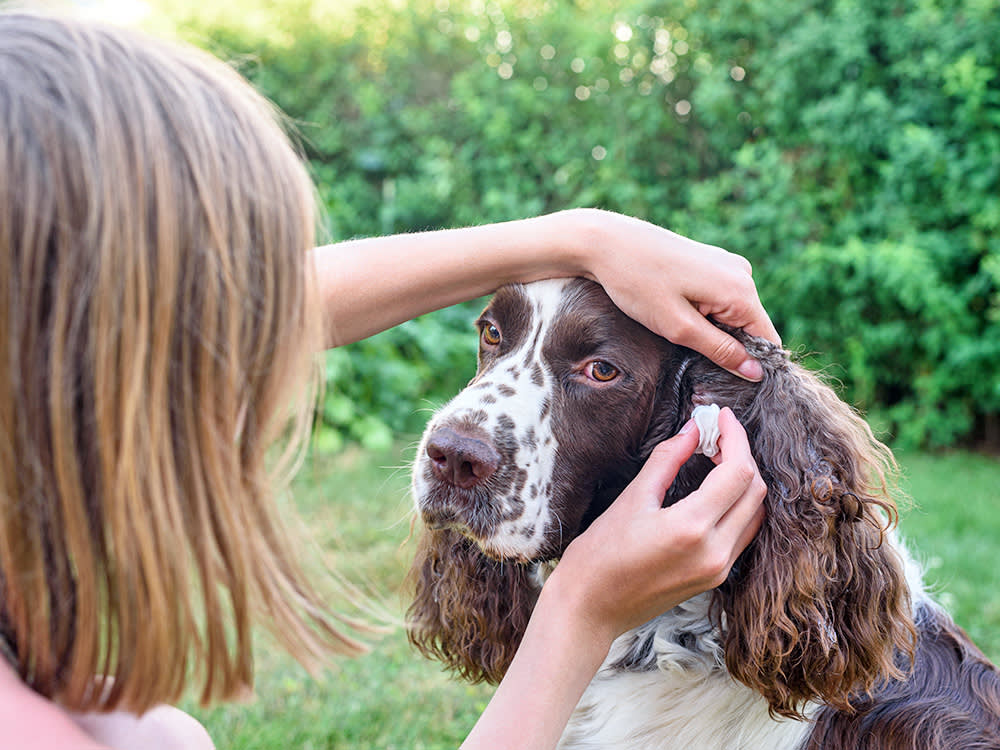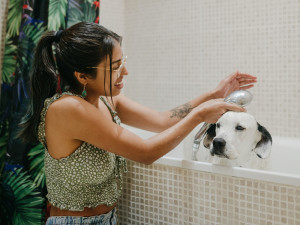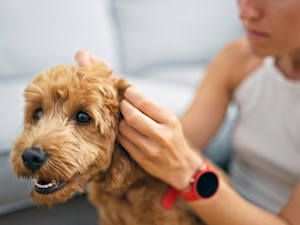How to Remove Earwax From Your Dog’s Ears
The best ways to get this done—safely and quickly.
In This Article:
When to Clean a Dog’s Ears What to Use to Clean Dog Ears How to Clean a Dog’s Ears Dog Ear Wax Color Chart: What Your Dog’s Earwax Color Means When to Seek Expert Help
Dogs’ ears are amazing contraptions capable of hearing sounds at distances up to half a mile away and frequencies that are so high we can’t even perceive them. All that amazingness does have a downside or two, however. One is that they aren’t as self-cleaning as our ears are and may often need cleaning to remove excess ear wax.
Sound daunting? It doesn’t have to – we’re here to help.
When to clean a dog’s ears
Our ears are pretty straight-forward. We have the outside pinna connected to the inner ear with a straight and flat ear canal.
How much do you spend on your pet per year?
A dog’s ears, on the other hand, are a little more complicated. That outside flap is connected to the inner ear by an ear canal that takes a sharp downhill route which then flattens out as it comes to the middle ear, forming sort of an L shape. This means that gravity is not on a dog’s ear’s side, so they may need your help when it comes to evacuating the ear canal of discharge, wax, and debris.
That doesn’t mean that every dog needs their ears cleaned frequently and aggressively. Instead, you may choose to clean them periodically as part of your dog’s routine healthcare, when grooming at home, or when there is a problem.
You’ll know your dog has an ear issue when their incessant head shaking has made you want to remove their collar in order to silence the jingling of their tags, or when they’d rather sit and scratch their ears than go for a walk. You’ll also know there’s a problem if they have a smelly discharge, redness, or heat emanating from their ears.
What to use to clean dog ears
First of all, don’t attempt to clean your dog’s ears until they’ve been checked by a vet. Your vet will determine if your dog’s eardrum is intact so that you don’t go filling the middle ear full of fluid. Your vet will also be able to recommend the best ear-cleaning product for your dog’s needs. However, here are a few to be aware of:
Ear cleaning solution for dogs
Your dog’s ears may respond better to a commercial ear-cleaning solution than they will to water. These solutions usually contain ingredients that help break down ear wax and dry the ear canal to prevent infections. There are many options, so speak to your vet about what will be best for your pup.
Also, don’t use any shampoos or soaps meant for other parts of your dog’s body as these can damage the inside of your dog’s ears.
Homemade dog ear cleaner
If commercial products aren’t your favorite, you can make a gentle, safe ear cleaner at home using everyday products. A solution that’s one part vinegar to two parts water will clean and dry the ear canal in most cases.
Ear flush for dogs
You may come across ear flush products for dogs. Flushing the ears involves putting a little pressure behind a solution in order to “blast” earwax and debris from the ear canal. This process is a little more complicated, so you may want to leave this to a professional.
How to clean a dog’s ears
Alright, now here’s where the rubber meets the road, or where the cleaner meets the ears, if you will. Keep in mind this process starts after a veterinarian has determined that it’s safe to clean your dog’s ears and you’ve selected the proper cleaner, whether homemade or commercial.
Step 1. Gather your supplies. You’ll need your chosen cleaner, a few paper towels or cotton balls (no cotton swabs, please), treats, and a helper if possible.
Step 2. With your dog sitting or lying down, position their hind end in the corner of a room and stand either to the side of them or gently straddling their body. If you have a helper, they may gently restrain your pup in whatever way feels comfortable.
Step 3. Lift the ear flap on one side and fill the ear canal with cleaner.
Step 4. Gently massage at the base of your dog’s ear while you listen to their pleasing groans.
Step 5. It may be impossible to keep your dog from shaking their head at this point, but if you can, wipe out as much cleaner and gunk as possible with cotton balls or a paper towel covering your fingertip.
Step 6. Allow your dog to shake their head and then wipe the ear again.
Step 7. Give treats and praise and repeat on the other side.
Dog ear wax color chart: what your dog’s earwax color means
Cleaning your dog’s ears allows you to get an up-close look at their ear wax. While this may not be something you ever dreamed of doing, taking note of the color can clue you into the status of your dog’s ear health.
Yellow to light brown: This is what you want to see. Normal, healthy ear wax typically has a light yellow to brownish color, similar to your own.
Dark brown or black: Ear wax that is darker in color usually indicates a problem. If it is dry and crumbly, it could mean ear mites, or if it’s brownish-gray and greasy, it could indicate an ear infection.
Green: Greenish ear wax with a stinky odor may be due to a fungal or yeast infection.
Red: This means blood could be coming from an injury in the ear or irritation caused by an infection or foreign object.
Along with color, also be on the lookout for a foul smell, redness or swelling in the ear, or excessive itching. Any color other than yellow or light brown, especially if accompanied by other signs, should warrant a trip to the veterinarian.
When to seek expert help
Any time you notice changes in your dog’s ears, call your veterinarian. Generally speaking, dogs can’t get rid of ear infections without a little intervention, so the sooner they get expert help, the faster their ears will be on the road to relief. Also, be aware that ear issues, such as infections and mites, if left untreated can lead to serious complications including hearing loss.
References
“How to Clean Your Dog’s Ears.” Cornell Riney Canine Health Center. https://www.vet.cornell.edu/departments-centers-and-institutes/riney-canine-health-center/canine-health-information/how-clean-your-dogs-earsopens in new tab.
“Itching Ear Problems.” Cornell Riney Canine Health Center. https://www.vet.cornell.edu/departments-centers-and-institutes/riney-canine-health-center/canine-health-information/itchy-ear-problemsopens in new tab.
Moriello, Karen, DVM. “Ear Infections and Otitis Externa in Dogs.” Merck Veterinary Manual. Sep 2024. https://www.merckvetmanual.com/dog-owners/ear-disorders-of-dogs/ear-infections-and-otitis-externa-in-dogsopens in new tab.











